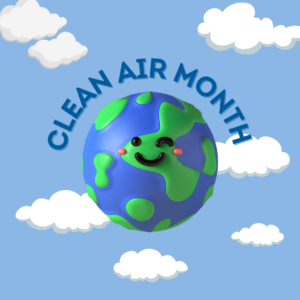 BREEZING INTO SUMMERTIME
BREEZING INTO SUMMERTIME
May is a month for celebrating! Graduations, Memorial Day, tolerable temperatures, and anticipation for the relaxation that summertime provides are all reasons to herald these special 30 days.
Did you know that May is also Clean Air Month? In 1972, the American Lung Association created the week-long event to raise awareness about the importance of clean air for public health and our environment. Clean air is important to human and ecosystem health, and at the Georgia Forestry Commission, we take pride in the tremendous air-cleaning services our state’s 24 million acres of forestland provide.
Trees can be likened to human lungs. They “inhale” and “exhale,” and when they do, they’re absorbing gaseous molecules in the air and scrubbing them clean. Through tiny pores on tree leaf surfaces, trees take in air that includes toxic pollutants. By a solar-powered process called photosynthesis, the leaves pull in carbon dioxide (CO2) and then convert it into sugars that feed the tree. The byproduct of that chemical reaction is oxygen – as in “cleaned air.” It’s estimated that one large tree can provide up to four people with a full day’s supply of oxygen!
And here’s the next amazing air-cleaning tree fact: trees store that carbon dioxide in their fibers, helping to reduce the negative effects that this CO2 could have had on our environment. The Arbor Day Foundation reports in one year a mature tree will absorb more than 48 pounds of carbon dioxide. Those amounts can be documented, and the GFC has a registry that serves this purpose in Georgia. Learn more about it here: https://gatrees.org/forest-management-conservation/carbon-sequestration/.
It’s important to monitor air quality in the summer, when particulate matter from vehicles and smoke can get trapped in the air and contribute to high ozone levels. These conditions have been linked to lung and heart disease in humans. And it’s why the GFC works closely with the GA Environmental Protection Division (EPD) and Department of Natural Resources to improve air quality across the state.
To help diminish air issues surrounding ozone pollutants, the Georgia EPD has instituted an outdoor burn ban every summer since 2005. While campfires, cooking fires, and some agriculture burns are permitted, 54 mostly north and central Georgia counties (listed below) do not allow yard and land debris clearing burns from May 1 to September 30. For complete details, visit https://epd.georgia.gov/air-protection-branch/open-burning-rules-georgia.
Georgia law classifies outdoor burning in several categories. In counties not included in the outdoor burn ban, the Georgia Forestry Commission reminds residents they must continue to follow specific laws, fire safety guidelines, and any local ordinances governing outdoor burning. The five safety precautions now mandated by law include set spacing between fires and woodlands and structures, burn times from sunrise to sunset, burner attendance at the fire, and reasonable precautions such as weather awareness and suppression tools. Full details including video resources can be found at https://gatrees.org/burn-permits-and-notifications/.
Georgia’s outdoor summer burn ban is in effect May 1-September 30 in the following counties: Banks, Barrow, Bartow, Bibb, Butts, Carroll, Catoosa, Chattooga, Cherokee, Clarke, Clayton, Cobb, Columbia, Coweta, Crawford, Dawson, DeKalb, Douglas, Fayette, Floyd, Forsyth, Fulton, Gordon, Gwinnett, Hall, Haralson, Heard, Henry, Houston, Jackson, Jasper, Jones, Lamar, Lumpkin, Madison, Meriwether, Monroe, Morgan, Newton, Oconee, Paulding, Peach, Pickens, Pike, Polk, Putnam, Richmond, Rockdale, Spalding, Troup, Twiggs, Upson, Walker, and Walton.
Georgia has enjoyed adequate rainfall as of late, however the risk of wildfire rises in summer. Because humans are the number one cause of wildfires, it’s important to pay close attention to weather conditions and safety precautions as we enjoy the great outdoors this season.
